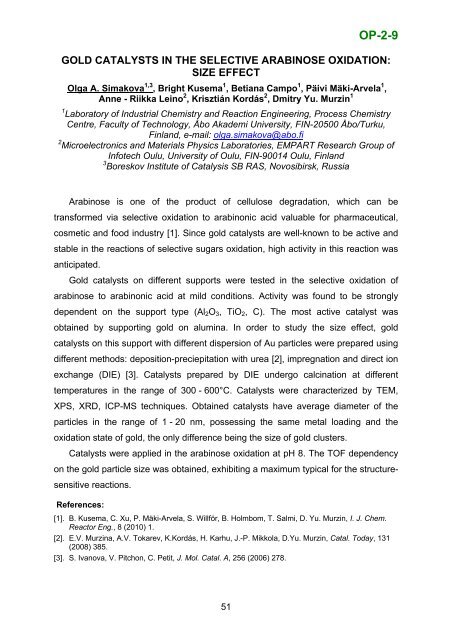Boreskov Institute of Catalysis SB RAS, Novosibirsk, Russia
Boreskov Institute of Catalysis SB RAS, Novosibirsk, Russia
Boreskov Institute of Catalysis SB RAS, Novosibirsk, Russia
- No tags were found...
Create successful ePaper yourself
Turn your PDF publications into a flip-book with our unique Google optimized e-Paper software.
OP-2-9GOLD CATALYSTS IN THE SELECTIVE ARABINOSE OXIDATION:SIZE EFFECTOlga A. Simakova 1,3 , Bright Kusema 1 , Betiana Campo 1 , Päivi Mäki-Arvela 1 ,Anne - Riikka Leino 2 , Krisztián Kordás 2 , Dmitry Yu. Murzin 11 Laboratory <strong>of</strong> Industrial Chemistry and Reaction Engineering, Process ChemistryCentre, Faculty <strong>of</strong> Technology, Åbo Akademi University, FIN-20500 Åbo/Turku,Finland, e-mail: olga.simakova@abo.fi2 Microelectronics and Materials Physics Laboratories, EMPART Research Group <strong>of</strong>Infotech Oulu, University <strong>of</strong> Oulu, FIN-90014 Oulu, Finland3 <strong>Boreskov</strong> <strong>Institute</strong> <strong>of</strong> <strong>Catalysis</strong> <strong>SB</strong> <strong>RAS</strong>, <strong>Novosibirsk</strong>, <strong>Russia</strong>Arabinose is one <strong>of</strong> the product <strong>of</strong> cellulose degradation, which can betransformed via selective oxidation to arabinonic acid valuable for pharmaceutical,cosmetic and food industry [1]. Since gold catalysts are well-known to be active andstable in the reactions <strong>of</strong> selective sugars oxidation, high activity in this reaction wasanticipated.Gold catalysts on different supports were tested in the selective oxidation <strong>of</strong>arabinose to arabinonic acid at mild conditions. Activity was found to be stronglydependent on the support type (Al 2 O 3 , TiO 2 , C). The most active catalyst wasobtained by supporting gold on alumina. In order to study the size effect, goldcatalysts on this support with different dispersion <strong>of</strong> Au particles were prepared usingdifferent methods: deposition-preciepitation with urea [2], impregnation and direct ionexchange (DIE) [3]. Catalysts prepared by DIE undergo calcination at differenttemperatures in the range <strong>of</strong> 300 - 600°C. Catalysts were characterized by TEM,XPS, XRD, ICP-MS techniques. Obtained catalysts have average diameter <strong>of</strong> theparticles in the range <strong>of</strong> 1 - 20 nm, possessing the same metal loading and theoxidation state <strong>of</strong> gold, the only difference being the size <strong>of</strong> gold clusters.Catalysts were applied in the arabinose oxidation at pH 8. The TOF dependencyon the gold particle size was obtained, exhibiting a maximum typical for the structuresensitivereactions.(References:[1]. B. Kusema, C. Xu, P. Mäki-Arvela, S. Willför, B. Holmbom, T. Salmi, D. Yu. Murzin, I. J. Chem.Reactor Eng., 8 (2010) 1.[2]. E.V. Murzina, A.V. Tokarev, K.Kordás, H. Karhu, J.-P. Mikkola, D.Yu. Murzin, Catal. Today, 131(2008) 385.[3]. S. Ivanova, V. Pitchon, C. Petit, J. Mol. Catal. A, 256 (2006) 278.51
















